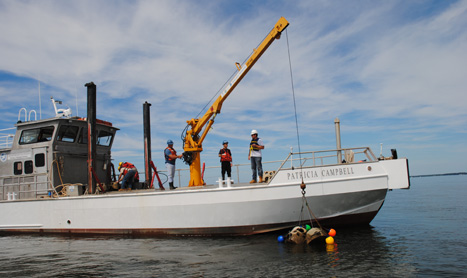COOK POINT – “Watch your toes.”
Not proffered advice, but a command shouted over the hum of a crane, this is Capt. Lloyd Lewis’ go-to phrase on the Patricia Campbell as the crew drops 100-pound concrete domes, called reef balls, into the water.
On Friday, Lewis and other volunteers hoisted around 50 reef balls at the Cook’s Point* oyster sanctuary near Cambridge, creating habitat for oysters and other marine life.
The trip marked the end of a five-year project headed by the Chesapeake Bay Foundation, which Capt. Karl Willey of the Bay Foundation hopes will help boost support for expanding oyster restoration.
Hope for Recovery
It’s no secret that oysters are suffering in the bay. Numbers still remain below 1 percent of their historic levels, according to a recent study from the University of Maryland.
“Bay oysters are virtually extinct,” Willey said.
Yet there is reason to hope for their recovery.
“They’re such a resilient animal that the populations left in the bay have been able to stay at fairly level amounts,” Willey said.
Historically over-harvested and hard-hit by diseases in the 1980s, oysters are now developing disease-resistance through natural breeding processes, Bay Foundation Communications Coordinator Tom Zolper said.
A recent focus on aquaculture may also take pressure off oyster reefs by creating an alternative source for fisheries.
Oysters continue to struggle against poor water quality in the bay and low reproduction rates — both problems that can be ameliorated by adding more oysters.
Living Habitat
There are three components to oyster restoration in the Chesapeake Bay: establishing no-harvest oyster sanctuaries, restoring natural oyster reefs and expanding aquaculture, Willey said.
Projects like Cook’s Point* rely on artificial materials to rebuild oyster reefs.
The once large oyster reefs — living towers of oysters tall enough to ground ships — were virtually wiped clean from the bay by overharvesting. Without them, tiny, free-swimming oysters sink to the sea floor, where sediment covers and suffocates them.
Reef balls mimic natural oyster reefs, providing surfaces that attract young oysters to settle. Not unlike the castles that adorn pet store fish tanks, the hollow, concrete balls also provide habitat for fish and crabs.
Each adult oyster can filter around 50 gallons of water each day, clearing sediment and improving water quality as they reform lost habitat.
“Oysters are the cornerstone to rebuilding the marine fisheries of the bay,” said Bay Foundation volunteer and member of Chesapeake Natives Christopher Puttock.
Blueprint for the Bay
Small-scale oyster restoration projects in the 1990s laid the groundwork for larger projects like Cook’s Point*.
While the Bay Foundation runs this project, volunteers form the backbone of oyster restoration, from the schoolchildren who helped assemble the reef balls to Lewis, who guides them into the water.
“What it takes is a lot of hard work,” Willey said. “We could not operate at our oyster restoration center efficiently without our volunteers.”
The Bay Foundation team is measuring success with different reef ball-to-acreage ratios and the number of oyster spat per reef ball, hoping to improve restoration practices and draw state and non-profit funding to expand projects in the future.
“It’s not leaps and bounds every year, but it’s grown,” Willey said of oyster restoration’s progress in the bay. “It’s a drop in the bucket, but we’re helping create a blueprint to save the bay.”
The Bay Foundation runs its oyster restoration project with funding from the National Oceanic and Atmospheric Administration and in partnership with the Maryland Saltwater Sport Fishermen’s Association, the Maryland Department of Natural Resources and the Maryland Artificial Reef Initiative.
To learn more about oysters in the Chesapeake Bay, visit http://www.cbf.org. Email Maryland Oyster Restoration Assistant Dan Johannes at djohannes@cbf.org to volunteer in oyster restoration projects.
* The original story incorrectly identified the site of the restoration project.



You must be logged in to post a comment.